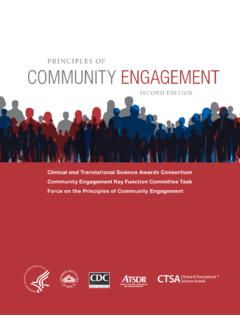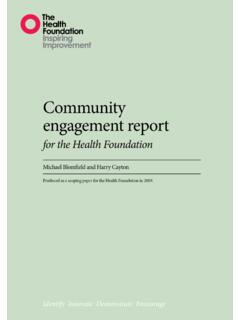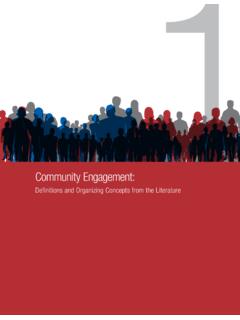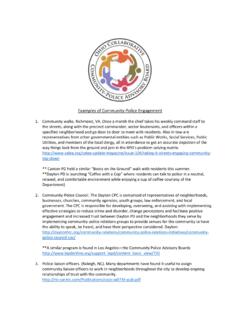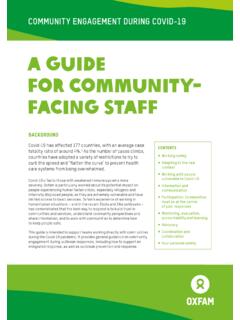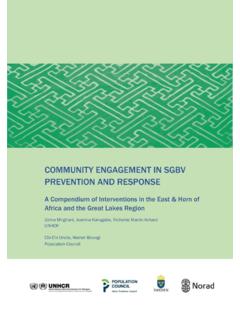Transcription of UNITED NATIONS COMMUNITY ENGAGEMENT …
1 UNITED NATIONSCOMMUNITY ENGAGEMENTGUIDELINES ON PEACEBUILDINGAND SUSTAINING PEACEU nited NationsPeacebuildingAUGUST Ant nio GuterresSecretary-General of the UNITED NationsFOREWORD Ant nio GuterresSecretary-General of the UNITED NationsLocal civil society actors, including women and youth, are often primary agents of peacebuilding, playing key roles in conflict-affected societies and in situations of extreme fragility or transition. They are critical in promoting confidence and trust, encouraging cooperation, creating incentives for collective action and ensuring that efforts are adapted to local and national contexts. Their contributions range from providing basic services to enhancing cohesion and stability; from enabling communities to influence social norms to mediating relationships between the government and people through dialogue or mechanisms for state accountability. As such, COMMUNITY ENGAGEMENT with local civil society actors is a central component of peacebuilding and sustaining peace.
2 This is why, in my 2018 report on Peacebuilding and Sustaining Peace (A/72/707 and S/2018/43), I called for wide-ranging efforts to strengthen this COVID-19 pandemic has made the value of COMMUNITY ENGAGEMENT clearer than ever. COVID-19 has caused an unprecedented worldwide crisis that is having devastating consequences on healthcare systems, livelihoods and the social contract, and threatens to aggravate long-standing inequalities and security challenges. Local civil society actors are rising to the challenge. In countries around the world, young women and men are delivering supplies to frontline health workers and people in need. They are developing innovative communication methods to maintain social cohesion despite physical distancing. We know from previous public health crises such as HIV/AIDS and Ebola that faith leaders have enormous influence, and we have seen that impact today in promoting unity and solidarity.
3 I am also grateful to the many local civil society actors worldwide who have echoed my appeal for a global ceasefire in order to focus our fight on our shared enemy the UNITED NATIONS , in its efforts to promote sustained peace and security, is strongly committed to directly and meaningfully engaging local populations and communities. It is in this precious civic space that we can interact with the people whose lives we hope to improve and who are affected by what we do. I urge UN colleagues to draw on these guidelines to advance our efforts to build and sustain OF CONTENTSINTRODUCTION .Objectives Peacebuilding and sustaining peace COMMUNITY ENGAGEMENT through local civil society actors RECOMMENDATIONS .Deeper understanding of local context through respectful, coherent and flexible ENGAGEMENT Operational and strategic coherence and effective coordination in COMMUNITY ENGAGEMENT across the UN at the country-level Safety and protection in restricted environments through conflict-sensitive and risk-informed approaches Inclusive and meaningful participation of local civil society actors COMMUNITY -based capacity-building, including flexible financing for peacebuilding Meaningful participation of local women and women civil society actors in peacebuilding and sustaining peace Meaningful youth ENGAGEMENT in peacebuilding and sustaining peace at the local level.
4 THE ROLE OF CIVIL SOCIETY IN FOSTERING STRATEGIC AND OPERATIONAL PARTNERSHIPSFOR PEACEBUILDING AND SUSTAINING PEACEAT THE LOCAL LEVEL ANNEXKey Documents and Training Resources on Peacebuilding and Sustaining Peace 4458111214182022 EXECUTIVE SUMMARY EXECUTIVE SUMMARYThe 2016 twin resolutions on the review of the UN peacebuilding architecture adopted in the General Assembly and Security Council (A/RES/70/262 and S/RES/2282 (2016), respectively) recognized the changing scale and nature of peacebuilding challenges. This led to shifting the long-term focus of the UN from crisis response to peacebuilding and sustaining peace, with a view to prevent the outbreak, escalation, continuation and recurrence of conflict, addressing root causes, assisting parties to conflict to end hostilities, ensuring national reconciliation and moving towards recovery, reconstruction and development through comprehensive and coherent approaches and strategic and operational partnerships including with civil society actors, especially women and youth-led the Secretary-General s call for the UN s improved ENGAGEMENT with civil society at the local level in his 2018 report on Peacebuilding and Sustaining Peace.
5 A joint UN-civil society working group developed the UN system-wide COMMUNITY ENGAGEMENT Guidelines on Peacebuilding and Sustaining Peace to:These Guidelines should also be understood in conjunction with the process, led by OHCHR and UN Women, to develop UN system-wide documents aimed at bringing more coherence to the UN s approach towards civic space. Support UN field presences in developing country-specific COMMUNITY ENGAGEMENT strategies on peacebuilding and sustaining peace; and Provide operational guidance to UN field presences on how to more effectively engage with civil society actors at the local level in peacebuilding and sustaining a geographical subset of society at the local level, a COMMUNITY can be defined by commonalities such as, but not limited to, norms, religion, shared interests, customs, values and needs of civilians. A COMMUNITY is not static or closed, but constantly evolving subject to internal and external construction and reconstruction.
6 COMMUNITY ENGAGEMENTA strategic process to directly involve local populations in all aspects of decision-making and implementation to strengthen local capacities, COMMUNITY structures and local ownership as well as to improve transparency, accountability and optimal resource allocations across diverse settings. In the context of peacebuilding and sustaining peace, COMMUNITY ENGAGEMENT is generally done through partnerships with a broad range of local civil society actors as intermediaries who work in the sphere of peacebuilding. For the UN, civil society is a broad concept including any collective civic arena of individuals, organizations, social movements, networks or coalitions that act or organize formally or informally to advance joint interests, values, objectives or goals of or across communities. In the context of the UN s ENGAGEMENT in peacebuilding and sustaining peace, the scope of civil society may be identified as, but not limited to: human rights defenders; independent media (online, off line); faith-based organizations and leaders; non-governmental organizations; COMMUNITY -based groups; professional groups or associations, including trade unions; women s groups; youth groups; religious, cultural, tribal or other informal organizations and civic movements that self-recognize as civil society; groups representing marginalized or underrepresented communities; social media communities; and academic institutions (schools, universities, research bodies).
7 Additionally, civil society can include informal gatherings or multistakeholder networks and coalitions. It is important to note the identity of local actors within civil society may be fluid and dependent on the context in conflict-affected SOCIETY1. In his report on Peacebuilding and Sustaining Peace, reflecting on the UN s ENGAGEMENT with civil society, the Secretary-General points to the range of forms this may take, including building capacity, sharing good practices, producing practical tools, fostering a conducive environment for robust civil society, and active ENGAGEMENT in analysis, planning, programming and monitoring and evaluation. He asked for the development, in consultation with civil society, of guidelines on system-wide ENGAGEMENT with civil society for sustaining peace (para. 61). He also asked for the UNITED NATIONS peace operations and UNITED NATIONS country teams develop COMMUNITY ENGAGEMENT strategies in consultation with national and local stakeholders, particularly youth and women s groups, and that these be shared, monitored and reviewed with local actors.
8 Peacebuilding Support Office (PBSO) of the Department of Political and Peacebuilding Affairs (DPPA) has led a joint UN-CSO Working Group (including Policy Planning Unit (PPU)/DPPA, Division of Policy, Evaluation and Training (DPET)/Department of Peace Operations (DPO), OHCHR, UNDP, UN Women, Global Partnership for the Prevention of Armed Conflict (GPPAC), International Peace Institute (IPI), Quaker UNITED NATIONS Office (QUNO) and UN entities). to develop the UN system-wide COMMUNITY ENGAGEMENT Guidelines on Peacebuilding and Sustaining Peace (UNCEG) through an innovative, uniquely inclusive and consultative SEVEN RECOMMENDATIONS .DEEPER UNDERSTANDING OF LOCAL CONTEXT THROUGH RESPECTFUL, COHERENT AND FLEXIBLE ENGAGEMENTC ommunity ownership through home-grown peacebuilding solutions that are prioritized and fostered through mutually beneficial, respectful and transparent understanding of each COMMUNITY s distinct context, including, but not confined to, language, demographic, ethnic groups, religion, culture and tradition etc.
9 Gendered, conflict-sensitive and risk-informed joint COMMUNITY contextual analysis and mapping of communities and local civil society actors as part of the Common Country Analysis (CCA).Operational flexibility including risk mitigation strategies that are adjustable to COMMUNITY -specific contexts..OPERATIONAL AND STRATEGIC COHERENCE AND EFFECTIVE COORDINATION IN COMMUNITY ENGAGEMENT ACROSS THE UN IN THE FIELDS treamlined COMMUNITY ENGAGEMENT at the country level through senior leadership. Designated civil society ENGAGEMENT capacity within the country presence to create and maintain a comprehensive and centralized database on communities and local civil society actors in peacebuilding and promote sustainable participation (in integrated UN mission settings, jointly managed central database). Centralized coordination role by the senior leadership complemented by strengthened individual COMMUNITY ENGAGEMENT capacities of various UN entities and agencies.
10 SAFETY AND PROTECTION IN RESTRICTED ENVIRONMENTS THROUGH CONFLICT-SENSITIVE AND RISK-INFORMED APPROACHES Do-no-harm approach during, before and after COMMUNITY , protect and expand civic space for robust COMMUNITY the consent of those involved, document any act of attack, threat, intimidation and reprisals against local civil society actors for engaging with the UN and devise appropriate protection measures to address the situation, including in cases of credible threats of physical violence. Context-specific protection needs and key safety and protection issues that can generate genuine progress included in COMMUNITY contextual analysis. Integration of advocacy goals for safety and protection of local civil society actors in the UN s broader partnerships with national and regional stakeholders. Regular full risk assessment and risk mitigation measures for safety, security and At the same time, it is important to be mindful that in some contexts culture and tradition could be the underlying cause of discrimination, oppression and marginalization of certain groups in communities which should not be reinforced by UN support.










